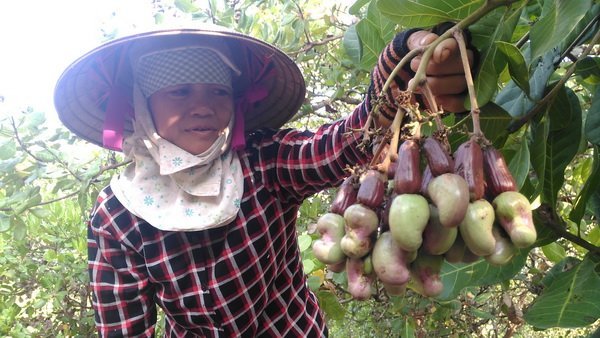
Cashew output in Binh Phuoc Province reached 1.4-1.5 tons per hectare in the 2013-2015 period, the Government news website reports. However, the volume has decreased since 2016, at 1.14 tons per hectare.
Tran Van Loc, director of the provincial Department of Agriculture and Rural Development, said at a conference in Binh Phuoc Province that Binh Phuoc has around 174,000 hectares under cashew cultivation, contributing a quarter of gross domestic product to the local agriculture sector and creating jobs for about 76,000 households there.
He added farmers in the province had a mere 500 hectares of new cashew trees last year. Meanwhile, their cashew trees that are over 20 years old cover about 25,000 hectares.
In addition to unfavorable weather, old cashew trees have weak resistance against pests and diseases, low capacity and poor quality. Therefore, the province’s cashew output only meets around 25% of production demand while the remainder depends on imports.
Other localities which are home to cashew exporters are in the same boat as Binh Phuoc.
“Owing to a serious shortage of material, the cashew sector cannot take a proactive approach to production,” said Nguyen Duc Thanh, chairman of the Vietnam Cashew Association (Vinacas).
Vinacas data shows that old trees make up about 30% of the cashew farming acreage. Besides, a staggering 80% of cashew trees have unknown origin and low capacity.
Vinacas chairman estimated each hectare of cashew cultivation costs around VND2 million, meaning that a thousand hectares requires about VND2 billion.
Therefore, he said a certain mechanism is needed for companies to fund farmers. Otherwise, they will continue purchasing raw material from other countries for their production.
Agriculture officials are still vague about technical barriers to Vietnamese cashew exports, so they cannot make appropriate recommendations for farmers, according to Pham Thi Thuy Yen, an agriculture authority in the southern coastal province of Ba Ria-Vung Tau.
Cashew is a billion-dollar export earner, with revenue amounting to US$3.6 billion in 2016, said Nguyen Van Loi, Party chief of Binh Phuoc Province.
However, he noted, “There are no specific assistance programs for the cashew sector, such as low-interest credit packages for farmers or firms.”
Thus, he proposed the Ministry of Agriculture and Rural Development consider cashew a nationally strategic product, and offer specific policies on debts and tax incentives for both farmers and firms.
The Government should monitor rampant cashew production, which can lead to an imbalance between supply and demand, said Ta Quang Huyen, director of Hoang Son 1 JSC.
Huyen added cashew safety and hygiene has yet to draw special attention from competent agencies. “If food safety and hygiene is not guaranteed, this will affect the brand of Vietnamese cashew nuts,” he said.
Thanh of Vinacas shared the same view, saying if farmers overuse pesticides and fertilizers to raise their output to three or four tons per hectare, they will certainly cause a safety crisis.
SGT